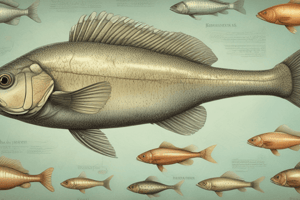Podcast
Questions and Answers
What is the kingdom and phylum of both Class Chondrichthyes and Class Osteichthyes?
What is the kingdom and phylum of both Class Chondrichthyes and Class Osteichthyes?
Kingdom Animalia, Phylum Chordata.
What is the main difference between Class Chondrichthyes and Class Osteichthyes?
What is the main difference between Class Chondrichthyes and Class Osteichthyes?
Osteichthyes have skeletons made of bone; Chondrichthyes are cartilaginous fish.
What are the two subclasses of Osteichthyes?
What are the two subclasses of Osteichthyes?
Subclass Actinopterygii, Subclass Sarcopterygii.
What are the general characteristics of bony fish (Osteichthyes)?
What are the general characteristics of bony fish (Osteichthyes)?
What are the different body shapes of Osteichthyes?
What are the different body shapes of Osteichthyes?
What is the fusiform body shape?
What is the fusiform body shape?
What is the compressed body shape?
What is the compressed body shape?
What is the elongated or attenuated body shape?
What is the elongated or attenuated body shape?
What is the depressed body shape?
What is the depressed body shape?
Which subclass of fishes is larger?
Which subclass of fishes is larger?
When were primitive Subclass Sarcopterygii abundant?
When were primitive Subclass Sarcopterygii abundant?
Most of Subclass Sarcopterygii are extinct, but which ones remain?
Most of Subclass Sarcopterygii are extinct, but which ones remain?
What partially extinct taxa do tetrapods descend from?
What partially extinct taxa do tetrapods descend from?
What is Order Scombriformes known for?
What is Order Scombriformes known for?
What is Order Coelacanthiformes known for?
What is Order Coelacanthiformes known for?
What does Order Salmoniformes include?
What does Order Salmoniformes include?
Flashcards are hidden until you start studying
Study Notes
Osteichthyes Taxonomy Overview
- Kingdom Animalia and Phylum Chordata encompass both Class Chondrichthyes and Class Osteichthyes.
- Key distinction: Osteichthyes possess bony skeletons, while Chondrichthyes have cartilaginous structures.
Subclasses of Osteichthyes
- Subclass Actinopterygii includes ray-finned fishes.
- Subclass Sarcopterygii comprises lobe-finned fishes, which are the evolutionary precursors to tetrapods.
Characteristics of Bony Fish (Osteichthyes)
- Skeletons are composed of bone.
- Fins, both paired and median, are supported by rays.
- Gills are the primary respiratory structures, protected by an operculum.
- Swim bladder is commonly present, aiding in buoyancy.
- Exhibits a wide variety of body shapes and skin coloration.
Body Shapes in Osteichthyes
- Fusiform: Torpedo-shaped, reducing drag for pelagic species like tuna.
- Compressed: Flattened laterally for improved maneuverability, typical in coral reef inhabitants such as butterfly fish.
- Elongated: Long bodies adapted for bottom-dwelling organisms, including trumpetfish and eels.
- Depressed: Flattened dorsally and ventrally, allowing resting on the bottom, seen in frog fishes and gobies.
Subclasses Size Comparison
- Actinopterygii is larger than Sarcopterygii in terms of species diversity.
Historical Context of Sarcopterygii
- Subclass Sarcopterygii thrived during the Devonian period, approximately 416-385 million years ago.
Extant Orders within Sarcopterygii
- Order Dipnoi: Known as lungfish, capable of breathing air.
- Order Coelacanthiformes: Coelacanths, large with lobed fins, previously thought extinct.
- Clade Tetrapodomorpha includes ancestral species of tetrapods, bridging fish and land mammals.
Characteristics of Order Scombriformes
- Includes tuna and mackerel, characterized by streamlined bodies and retractable fins.
- Species lengths vary significantly, from 20 cm (7.9 in) to 4.58 m (15 ft) for Atlantic bluefin tuna.
- Highly adapted for speed, capable of reaching 50 mph underwater, with notable examples like the yellowfin tuna exhibiting partial warm-bloodedness.
Features of Order Coelacanthiformes
- Coelacanths can grow up to 5 feet, exhibiting blue-grey coloration with white spots.
- They have low-density lipids in their swim bladders and lobed fins.
- Ovoviviparous reproduction with a gestation period of 11 months.
- Known as a Lazarus taxon, coelacanths were rediscovered in 1938 after being presumed extinct since the Late Cretaceous.
Overview of Order Salmoniformes
- Comprises salmon, trout, and related species known collectively as salmonids.
- Features slender bodies, rounded scales, and forked tails, adapted for varied aquatic environments.
Studying That Suits You
Use AI to generate personalized quizzes and flashcards to suit your learning preferences.




